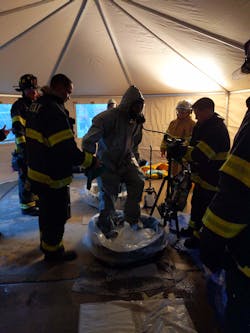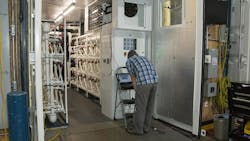This year seems to be moving by quickly, particularly with COVID-19 happening as of this writing. One thing that is rather consistent is how trends seem to come about once a decade. In the 1980s, it was hazmat teams; the 90s, it was rope rescue; in the 2000s, rapid intervention teams came to the fore; in the 2010s, technical rescue teams began trending.
With the 20s starting, we’re keeping our eyes out for the next big thing—a place to begin training, to start discussions and to improve techniques.
With knowledge comes understanding, and with understanding comes mastery.
Biologicals
How could we not begin with this topic? I believe that most of those who are in the fire service know the term TRACEM, the standard mnemonic to remember the classic hazards of hazardous materials (thermal, radiological, asphyxiant, chemical, etiological [biological] and mechanical). The biological component often was overlooked, because it wasn’t encountered by many first responders.
We could go back to the beginning of time to list all of the pandemics and epidemics, but let’s stay within recent history, starting with Sept. 11, 2001. At the time, there was a sudden surge of so-called white powder incidents. On September 18, numerous anonymous letters that contained anthrax began to arrive at media companies and congressional offices. Although the total number of anthrax incidents can’t be determined definitively, it was estimated in the dozens.
Since then, we heard about and prepared for numerous other biological problems. Whether Zika or Ebola, MERS or SARs, H1N1 or AIDs, responders have taken steps to ensure the safety of the public and of themselves. That said, we would venture that if you asked the average responder what affected him/her the most, the answer would be COVID-19. Why? Virtually all life came to a halt. (Early in the year, COVID-19 was nothing more than an internet meme or an office joke.)
The point of understanding biologicals is so we don’t make the same mistakes. We are finding vulnerabilities in our infrastructure from the highest levels of government to the smallest level of personal awareness. Take notes, read vetted information, and better yourselves and your departments. Those of you who take the time to read publications, such as this one, are the ones who move mountains, influence change and spark movements.
Through interviews and conversations with responders, we found that the average rescuer was prepared for the tasks of keeping the public safe, taking measured and deliberate risks and being ready for the unknown. However, many of them were unprepared for the number of requests, for the need for PPE and for the inability to see the enemy for such a significant amount of time.
In the future, we must understand that alternate methods of PPE use might come to light. There have been times during the COVID-19 event that PPE needed to be reused, and I believe that many of us were surprised that we didn’t have a fresh mask or gloves waiting for us whenever we moved on to a new task.
Take time from your regularly scheduled training to try to understand this topic. Converse with people in the field, both emergency and professional. People who work in labs know and understand the way that these organisms work and how to keep ourselves out of trouble. However, these same people expect emergency workers to have a solid handle on how to mitigate things. Unfortunately, responders expect the responsibility to be on the lab workers to fix the problem. This is something that we need to discuss as a community.
Dry decontamination
The term dry decon is a little misleading. In reality, “dry” includes a little bit of water. Compared with the current methods that we employ to decontaminate people, it’s a drastic departure from the “car wash” method. When we talk to people in the community, many of them never heard of this.
Dry decon is a technique that has been used by the military and some hazmat teams for a long time. Depending on the method, it uses about a half-gallon of water to decontaminate about 12 people. This improves outcomes in cold weather, deep in a building or other circumstances in which water is scarce. The technique is effective for chemical, biological and radiological issues in all phases of matter.
The FDNY was one of the departments that pioneered the changeover to dry decon. Your department very well might have been employing dry decon for a long time despite referring to it as something else. (If you did a boot wash in a pool of water or used a spray bottle of decon solution, you did a variant of dry decontamination.)
We don’t have the column space to provide complete dry decon instructions, but we can tell you about the advantages of the technique. To begin, the footprint of the operation is small. (We usually set it up with two members running the entire decon line, and the whole thing fits into a large duffle bag.) The only thing that you need for the majority of cases is a couple of sport bottles of water from the convenience store.
The process usually is a variant of wiping off the gross/bulk contaminant and possibly spraying on a surfactant and/or a decontamination solution to degrade a chemical or biological. When wiping, pay attention to the areas in which the operator comes in contact. In other words, essentially, we don’t care whether the knee of PPE is dirty; we care about the zipper that the member might touch during undress.
We particularly like the departure from chemicals that have a higher vapor pressure. In the past, the only question was, “Do we use soap?” We would wash everyone the same. Now, we let chemistry do its chemistry thing. If the vapor pressure is moderately high (for our method, we use >150mm Hg), we stand the person in front of a fan and let the fan do its work.
Dry decon also helps when operating on, say, the 18th floor of a building. In the past, we used to set up decon on the ground floor in front of the building for when members exited. Doing dry decon at the site of where personnel operate reduces contamination that could occur when personnel walk from the site of the operation to the building exit. This is a win for the building owner and for personnel, who otherwise would have to stay in PPE for the time that it takes to come down from upper floors.
More than 600 members of the FDNY were taught dry decon. It now is in full effect. (We have no plans to do this for the civilian population, but that might change.)Energy storage systems
As renewable solar and wind energy starts to proliferate in many localities, the subject of energy storage systems (ESS) is springing up everywhere. As renewable sources of energy are married to ESS—or batteries, as some who are in the fire service call them—they are appearing in private homes, on rooftops of multifamily dwellings and on entire floors of high-rises. Additionally, newer designs are finding their way into shipping containers that are retrofitted with an incredible amount of electronics, suppression systems and hazmat. As a result, firefighters will be faced with a new set of challenges.
ESS can scale in size from something small that’s attached to a private dwelling and contains stored energy in the kWh range, to utility-scale size that contains MWH of stored energy. These systems and their various components are extremely complex. Some manufacturers provide responder training, but it’s usually site-specific education.
The confusion with these installations is rooted in the type of battery that’s used. So, a little understanding prior to an incident goes a long way in the preparation for safe handling. For example, you might find lead acid (which has sulfuric acid), nickel cadmium, nickel-metal hydride or lithium ion.
The event in Surprise, AZ, in April 2019 in which an explosion at a battery storage facility hospitalized four firefighters with serious injuries hammers home the importance of understanding proper storage, ventilation tactics, suppression methods and types—even where to stand.
One of the calls that we typically get is how to put out a fire, because the use of the wrong agent might make the situation worse. Although the jury still is out on a hard and fast rule on operations and standards, it can be said that we must be very careful in regard to thermal runaway. When a cell starts to thermally decompose, it throws off a lot of heat and flammable gases. The heat starts to propagate to the next cell, which starts that next cell to begin to decompose and to throw off even more gases. As you would expect, these installations are in an enclosed space, and once enough gas fills the space, we presumably will be in the flammable range and an explosion could occur.
It is being recommend that cells first should be de-energized and then isolated. The main objective is to begin to cool them. Luckily, we bring water, and the cooling effect of water is tremendous. However, to cool cells, we must gain access to the space where the batteries are stored. As well, we need to vent to bring the atmosphere out of the flammable range.
Then there’s the smoke and what’s in it. Use your meters. They’ll read flammable gases and carbon monoxide, but they can sense a bevy of other things, too. In short, wear your SCBA.
We hope that these topics will inspire you to ask questions, to strive to gain an answer and to pursue a deeper understanding of what is coming for the future of hazmat.
Get More Involved
Within our departments, more often than not, we know who are the few people who we want working when a hazmat event occurs. However, when we ventured onto the teaching circuit, we were amazed at the widespread level of proficiency. This is why it’s crucial to venture outside of your own pond—to get a different perspective on thought processes, techniques, tools and attitude.
In this magazine and others, articles speak to fund cuts, doing more with less and becoming more efficient. So, how do we expand our horizons to truly become a better hazmat operator? Let’s take a look at a few for free—because who doesn’t love free?
Podcasts that are found on all of the platforms (including YouTube) cover topics that are appropriate for the awareness level through to the specialist level. The capability for a podcast to teach while in the car or while doing housework can’t be overstated.
We won’t deem one platform better than another, but Facebook and Reddit are outstanding for our purposes. Facebook groups are ideal for collaboration on hazmat, what with the platform’s functionality that permits: videos and clips to be posted; input to be solicited; and advice to be garnered. (We are part of at least a dozen Facebook groups, and we regularly interact with members.) Reddit has proven quite useful for monitoring the coronavirus situation, given that the platform supplies the means to subscribe to thousands of subgroups.
Offline, there are dozens of U.S. conferences and many more internationally that, if you or your department can afford the cost of travel and admission, provide total immersion in the hazmat culture. Networking with speakers and others who are in the field can be invaluable.
Meters for Operations-Level Personnel
Metering for most firefighters is “just part of the job”—pick up the meter, wave it around; if no beep, then leave. This indifferent effort isn’t a result of laziness; it occurs because there is a fundamental lack of understanding for what meters tell us and what to do with that information.
Metering is a mission-specific competency for hazardous materials operation personnel and a standard proficiency for technician level and above. If you are an operations-level firefighter, you have the option of getting up to six additional competencies to expand your operation capabilities. One of those is metering.
The standard meter that’s found on apparatus is the four-gas meter, which tracks oxygen levels, carbon monoxide (CO), hydrogen sulfide and flammability. These are considered mainstays of monitoring and are in Occupational Safety and Health Administration’s confined-space standard.
Where more emphasis can be placed: When a meter beeps, what does it mean? Let’s take a few seconds to provide some what-ifs for operations-level firefighters.
If the oxygen level goes down—put on our SCBA, make rescue if possible, leave the area.
If the oxygen level goes up—DANGER: put on your SCBA immediately, rescue on the way out, leave.
If the CO level is slightly elevated and persistent, ask the questions: Is there plumbing being done? (We’re looking for acetylene, which is a cross-sensitivity for CO; if plumbing is being done, find cylinders, remove from area, vent and monitor); Are there batteries that are charging? (We’re looking for things such as a stairlift for older people or a motorcycle in a garage; batteries in such devices trickle-charge, and over-charging of batteries can produce hydrogen, which is a cross-sensitivity for CO; if a charging battery is found, remove it from power, remove the battery from the area if possible, ventilate and monitor).
If the hydrogen sulfide level goes up—put on your SCBA, make rescue if possible and leave the area.
If the flammability level goes up to 10 percent of the lower explosive limit (LEL)—put on your SCBA, try to isolate the source, ventilate, make rescue if possible and monitor.
If the flammability level goes beyond 10 percent LEL—take immediate action to prevent a fire or explosion (take steps to stop or slow source), ventilate, make rescue if possible and monitor.
Are the points above a simplified set of rules that are statistically based for a majority of calls? Yes. Do they take every possible permutation into account? No. There is no way that every scenario could be addressed here. That is why a basic understanding leads to a set of questions that are to be answered.

Bobby Salvesen
Bobby Salvesen retired in 2022 after more than 25 years of service with FDNY and Hazmat Co. 1. He is a Nassau County, NY, Fire Service Academy hazmat instructor and is co-host of The Haz Mat Guys podcast. Salvesen studied chemistry at New York Institute of Technology, SUNY-Old Westbury and SUNY-Empire State.
Michael Monaco
MICHAEL MONACO is an 18-year veteran of the FDNY. He has been assigned to Hazmat Company 1 for the past 15 years. Monaco holds a bachelor of science degree in biochemistry. Bobby Salvesen and Monaco co-host “The Hazmat Guys” podcast.







